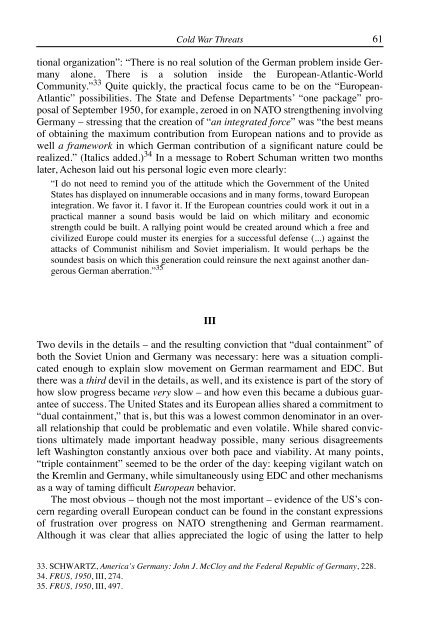journal of european integration history revue d'histoire de l ...
journal of european integration history revue d'histoire de l ...
journal of european integration history revue d'histoire de l ...
Create successful ePaper yourself
Turn your PDF publications into a flip-book with our unique Google optimized e-Paper software.
Cold War Threats 61<br />
tional organization”: “There is no real solution <strong>of</strong> the German problem insi<strong>de</strong> Germany<br />
alone. There is a solution insi<strong>de</strong> the European-Atlantic-World<br />
Community.” 33 Quite quickly, the practical focus came to be on the “European-<br />
Atlantic” possibilities. The State and Defense Departments’ “one package” proposal<br />
<strong>of</strong> September 1950, for example, zeroed in on NATO strengthening involving<br />
Germany – stressing that the creation <strong>of</strong> “an integrated force” was “the best means<br />
<strong>of</strong> obtaining the maximum contribution from European nations and to provi<strong>de</strong> as<br />
well a framework in which German contribution <strong>of</strong> a significant nature could be<br />
realized.” (Italics ad<strong>de</strong>d.) 34 In a message to Robert Schuman written two months<br />
later, Acheson laid out his personal logic even more clearly:<br />
“I do not need to remind you <strong>of</strong> the attitu<strong>de</strong> which the Government <strong>of</strong> the United<br />
States has displayed on innumerable occasions and in many forms, toward European<br />
<strong>integration</strong>. We favor it. I favor it. If the European countries could work it out in a<br />
practical manner a sound basis would be laid on which military and economic<br />
strength could be built. A rallying point would be created around which a free and<br />
civilized Europe could muster its energies for a successful <strong>de</strong>fense (...) against the<br />
attacks <strong>of</strong> Communist nihilism and Soviet imperialism. It would perhaps be the<br />
soun<strong>de</strong>st basis on which this generation could reinsure the next against another dangerous<br />
German aberration.” 35<br />
III<br />
Two <strong>de</strong>vils in the <strong>de</strong>tails – and the resulting conviction that “dual containment” <strong>of</strong><br />
both the Soviet Union and Germany was necessary: here was a situation complicated<br />
enough to explain slow movement on German rearmament and EDC. But<br />
there was a third <strong>de</strong>vil in the <strong>de</strong>tails, as well, and its existence is part <strong>of</strong> the story <strong>of</strong><br />
how slow progress became very slow – and how even this became a dubious guarantee<br />
<strong>of</strong> success. The United States and its European allies shared a commitment to<br />
“dual containment,” that is, but this was a lowest common <strong>de</strong>nominator in an overall<br />
relationship that could be problematic and even volatile. While shared convictions<br />
ultimately ma<strong>de</strong> important headway possible, many serious disagreements<br />
left Washington constantly anxious over both pace and viability. At many points,<br />
“triple containment” seemed to be the or<strong>de</strong>r <strong>of</strong> the day: keeping vigilant watch on<br />
the Kremlin and Germany, while simultaneously using EDC and other mechanisms<br />
as a way <strong>of</strong> taming difficult European behavior.<br />
The most obvious – though not the most important – evi<strong>de</strong>nce <strong>of</strong> the US’s concern<br />
regarding overall European conduct can be found in the constant expressions<br />
<strong>of</strong> frustration over progress on NATO strengthening and German rearmament.<br />
Although it was clear that allies appreciated the logic <strong>of</strong> using the latter to help<br />
33. SCHWARTZ, America’s Germany: John J. McCloy and the Fe<strong>de</strong>ral Republic <strong>of</strong> Germany, 228.<br />
34. FRUS, 1950, III, 274.<br />
35. FRUS, 1950, III, 497.

















